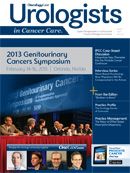Publication
Article
Oncology Live Urologists in Cancer Care®
Surveillance Following Orchiectomy Most Costly Option for Stage I Testicular Seminoma
Author(s):
A cost analysis found that para-aortic radiotherapy, dogleg radiotherapy, and 1 cycle of carboplatin are cost-effective strategies for the management of stage I testicular seminoma post-orchiectomy compared with surveillance.
John A. Cox, MD
A cost analysis presented at the 2013 Genitourinary Cancers Symposium found that para-aortic radiotherapy (PA-RT), dogleg radiotherapy (DL-RT), and 1 cycle of carboplatin are cost-effective strategies for the management of stage I testicular seminoma post-orchiectomy compared with surveillance, when reimbursement costs for salvage bleomycin, etoposide, platinum (BEP) chemotherapy are factored in after potential relapse.
An estimated 8000 new cases of testicular germ cell tumors will be diagnosed each year in the United States, and about 50% will be stage I seminoma treated with radical orchiectomy. Approximately 80% to 85% of patients can be managed by surveillance, since the relapse rate is about 18%. Tumor size does not exclude patients from surveillance.
Salvage radiotherapy with either technique and cisplatin-based chemotherapy are highly effective for patients at relapse, explained presenting author John A. Cox, MD, University of Texas Medical Branch, Galveston.
The impetus for the cost analysis was a change in the National Comprehensive Cancer Network (NCCN) guidelines from 2011 to 2012, scaling back the use of imaging and lab tests after orchiectomy, driven in part by results of randomized trials, as well as a desire to reduce exposure to frequent CT scans.
The goal of the cost analysis was to compare costs associated with each management strategy (ie, surveillance, PA-RT, DL-T, and carboplatin) in 2011 and 2012, as well as costs associated with the required 10-year follow-up for each strategy.
To construct this analysis, the investigators assumed that the 5-year failure rate was 18% for surveillance, 4% for each radiotherapy technique, and 5% for carboplatin. Medicare reimbursement rates were used to determine the actual reimbursement for each treatment course over a 10-year period.
Factoring in the costs of salvage therapy, the total Medicare reimbursement was $10,643 for surveillance, $11,648 for PA-RT, $9662 for DL-RT, and $7870 for carboplatin under the 2012 NCCN guidelines. In 2011, reimbursement for the four strategies was $20,986, $11,517, $9394, and $20,365, respectively.
Without factoring in the cost of salvage therapy with BEP, based on 2012 reimbursement rates and the 5-year relapse-free survival rates, surveillance was less costly than adjuvant radiation and no incremental benefit was seen for surveillance compared with carboplatin, since the cost of surveillance was much higher. However, when salvage BEP therapy was factored in, surveillance alone was more costly and less effective compared with the other three strategies.
Cox acknowledged that the study had several limitations. These men have a long life expectancy and the analysis did not account for quality of life, nor did it include quality-adjusted data.
Cox JA, Gajjar SR, Lanni TB, Swanson TA. Cost analysis of adjuvant management strategies in early-stage testicular seminoma. J Clin Oncol. 2013;31(suppl 6; abstr 320).









